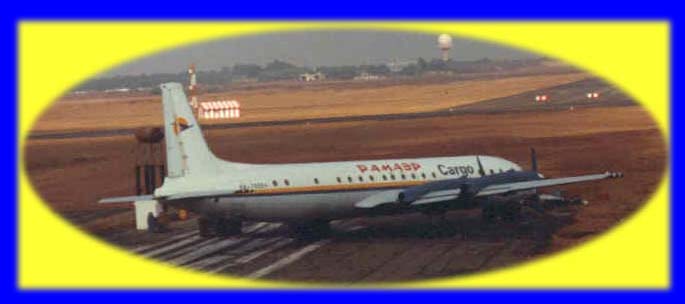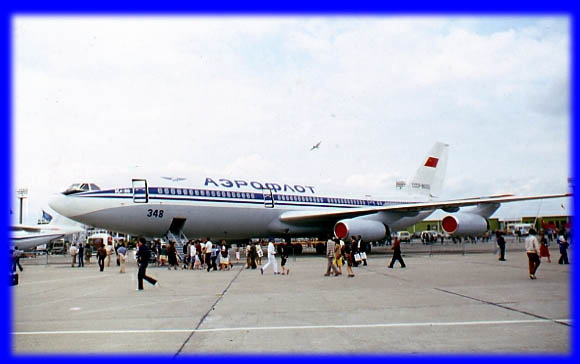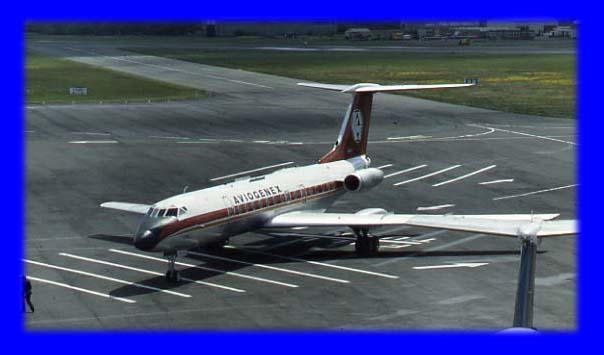|
| |
Back to
airliners
|
 |
Antonov An24RV
Skopje, October 2007 |
 |
Designed by the bureau founded in Ukraine by
Oleg Antonov, The Antonov An72 (Nato codename `Coaler') is very unusual in having the two
turbofan engines mounted above and forward of the wing. The idea is
for the jet exhaust to increase the airflow over the wing and thus
improve performance, especially at low speed. A similar
configuration was used on the Boeing YC-14 in the mid 1970s.
The An72 is used mainly to transport freight to
semi-prepared rough airstrips in the remoter parts of the former
Soviet Union. This one visited Farnborough in September 1984. |
 |
The Antonov An124 Ruslan (NATO codename Condor),
which first flew in December 1982, wrested the title of the world's
largest aircraft from the American Lockheed Galaxy, and held it
until Antonov produced the one-off six engined An225 Mriya
(`Dream'). Powered by four Lotarev (now Progress) D18T turbofand of
51,590lb thrust, its maximum take-off weight is a thumping
893,000lb. It can carry a maximum payload of 132 tons at 500mph for
a range which may be anywhere from 2,600 to 9,800 miles, depending
on the payload / fuel trade-off. It is 226 feet 9 inches long, and
has a wing span of 240 feet 6 inches.
This one was at the start of its take-off roll at Farnborough, September 1988 |
 |
The Ilyushin Il18 (Nato codename Coot) was essentially a Russian
competitor to the Bristol Britannia and Lockheed Electra. It carries
up to 120 passengers over a range of 2,300 miles. First flown in
1957, it quickly proved sturdy and reliable, essential in the hostlie Russian environment.
Few survive today. This example had been used
as a freighter but, when photographed at Johannesburg in 1999, had
obviously not flown for quite some time. |
 |
The Ilyushin Il62 (Nato codename Classic) was the Soviet Union's
answer to the Boeing 707 for long range intercontinental transport.
It first flew in January 1963, and bore an uncanny resemblance to
the British VC10 which had flown the previous year. However, with a
huge captive market, more Il62s were built (250).
Particularly noteworthy is the drooped wing
leading edge in the outboard section, designed to avoid the problem
of `deep stall' which can affect T-tail aircraft. This is typical of
the simple, practical approach the Russians take to problem solving.
This is an Il62M (with uprated engines), seen
at London Heathrow in August 1979. |
 |
The Ilyushin Il86 (Nato codename Camber) was Russia's first wide
bodied airliner. It seats up to 350 people. 103 were built before it
was superseded by the better Il96. One unusual feature, specifically
designed for remote Russian airfields without proper handling
facilities, is that passengers can board the aircraft through the
cargo hold, loading their own luggage into racks, and walking
upstairs to their seats.
This Il86 was seen at Paris - Le Bourget in
June 1981. |
 |
The Ilyushin Il96 first flew in September
1988, which was just too late for it to be favoured with a NATO
codename. It is a complete redesign of the Il86, with more modern
and fuel-efficient engines, aerodynamic improvements including
drag-reducing winglets, and an advanced cockpit and flight control
system. It is powered by four Soloviev PS-90 engines of 35,970lb
thrust, though the Il96M or T versions have American Pratt & Whitney
PW2337s of 37,000lb thrust. It can carry up to 300 people (375 for
the Il96M) at 520mph for up to 7,000 miles, and weighs in at up to
595,000lb. It is 181 feet 7 inches (212 feet 3 inches for the Il96M)
long, with a wing span of 197 feet 3 inches. Since the breakup of
the former Soviet union and the splitting up of the former State
airline monopoly, Aeroflot, the plethora of small airlines which now
dominate Russian aviation find it had to afford machines like this,
so very few have been built; however, it remains in production as at
March 2006.
This one, operated by Aeroflot, was at a very wet
Seoul in July 2005. |
 |
The Tupolev Tu134 (Nato codename Crusty) was developed from the
Tu124 (`Cookpot'), which in turn was developed from the Tu16 (`Badger') bomber
of the 1950s. First flying in 1962, it quickly became established as
the standard Russian medium range airliner. Several hundred were
built before production ended in the early 1980s. It typically seats
75 people. This Tu134, operated by the
Yugoslav charter airline Aviogenex, was seen at Newcastle in the mid
1970s. |
 |
The Tupolev Tu154 (Nato codename Careless) was Andrei Tupolev's answer
to the Boeing 727. It has higher seating capacity (up to 180 people)
than the Tu134, and much longer range (2100 miles). Performance is
thus pretty comparable with its American counterpart, except for
fuel consumption! About 900 have been built in all variants.
This Tu154M, operated by Hungarian airline Malev,
was seen at London Heathrow in August 1979. |
 |
The Yakovlev YAK42 (Nato codename Clobber; in the middle of this
rather crowded picture) is a relatively small feeder airliner, with
seating for up to 120 people, designed to replace the Tu134. It
first flew in March 1975. Despite its use of small turbofan engines
(like the BAe146), the fact that there are three of them made it
more expensive to operate than the aircraft it was intended to
replace. As a result relatively few were built, and they now operate
in tandem with the older Tupolev designs.
This YAK42 was seen at Paris - Le Bourget in June
1981. |





|